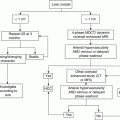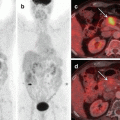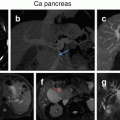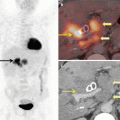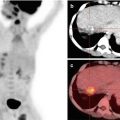Fig. 2.1
Moderately differentiated adenocarcinoma of the gall bladder. (a) Tumour invades the gall bladder adventitia and is close to liver parenchyma (low power). (b) High-power view of adenocarcinoma
Squamous carcinoma , small-cell neuroendocrine carcinoma and undifferentiated carcinoma are some of the uncommon types of carcinomas, each forming upto 3% [4, 6]. Histologically, squamous differentiation in the adenocarcinoma of the gall bladder is common. Hence, diagnosis of a primary squamous carcinoma of the gall bladder is made after extensive sampling and after excluding gland formation as well as any other secondary tumour.
Undifferentiated carcinoma lacks gland formation and can have spindle cells, giant cells and pleomorphic cells. They are very aggressive tumours which frequently metastasize.
The prognosis depends on the stage of the disease.
Nonneoplasic lesion of the gall bladder includes inflammatory polyp, adenomyoma and cholesterol polyps.
Liver cancer is much more common in men than in women. In men, it is the second leading cause of cancer death worldwide and in fewer developing countries [1].
Liver cancer rates are the highest in East and Southeast Asia and Northern and Western Africa. Most primary liver cancers (70–90%) are hepatocellular carcinomas (HCC) (Fig. 2.2). Chronic liver disease and cirrhosis remain the most important risk factors for development of HCC of which viral hepatitis and excessive alcohol intake are the leading risk factors worldwide [7]. Several histological patterns are identified such as clear cell type, adenomatoid, small cell type, etc. Fibro lamellar HCC is a special variant which is seen in young adults and occurs in the liver that are normal. No risk factors are identified for this variant.


Fig. 2.2
Hepatocellular carcinoma . Histology shows hepatoid tumour cells having rather sheeted appearance and foci of necrosis. No portal triads are seen
Other type of cancers includes cholangiocarcinoma, hepatoblastoma (in younger age) and angiosarcoma.
Cholangiocarcinomas (CC ) can have similar histological and immunohistochemical (IHC) profile to that of gall bladder and pancreatic adenocarcinomas. The distinction of cholangiocarcinoma from HCC on a needle-core biopsy can be tricky. HCC are generally immunopositive for Heppar-1 and glypican 3, whereas CC are positive for CK7, CK20 and CK19 and are negative for Heppar-1 and glypican 3. But often, histopathologist looks at clues such as tumour markers (raised alfa feto protein levels versus raised serum Ca19.9/CEA levels) and contrast enhancement in arterial phase on CT scan. Combined hepatocellular and cholangiocarcinoma (CHC) is a recognised entity and accounts for 0.4–14.2% of primary liver cancers. They have overlapping histological features of both HCC and CC [8].
Hepatoblastoma is the most common malignant liver tumour in children and comprises approximately 1% of all paediatric cancers. Nearly 90% of cases occur in the age group of 6 months to 5 years. It is seen typically as a large single mass, occurs in normal livers and almost always shows a marked rise in serum alfa feto protein levels [4]. Histologically, they are of epithelial and mixed epithelial and mesenchymal type and can show cartilage/osteoid, which may give diagnostic clues in imaging. Extramedullary haematopoiesis is often seen in these tumours.
Hepatocellular adenoma is seen mostly in young women during reproductive age and is uncommon in males. They are often solitary and occur in livers that are normal. Long-term use of oral contraceptive pills (OC pills) and use of anabolic steroids are risk factors. Other risk factors include diabetes, glycogen storage diseases types I and IV, tyrosinemia and galactosemia [4]. Hepatic adenoma shows proliferation of hepatocytes with minimal atypia, but with lack of portal zones. The reticulin framework is often maintained. Immunohistochemistry is not helpful in the diagnosis.
Bile duct adenoma is a localised benign ductular proliferation of bile ducts. They are subcapsular in location, smaller than 2 cm in size, and are usually single. They are often sent for frozen section examination to exclude metastatic adenocarcinoma. This can be a difficult diagnosis. Round outline and lack of atypia can point towards this diagnosis.
2.3 Pancreatic Carcinoma
Pancreatic carcinoma is one of the most lethal of all solid malignancies despite therapeutic and research advances. Five-year survival is less than 5% [9].
The incidence rates and mortality rates of pancreatic cancers are generally higher in the USA, Europe, Australia and Japan and lower in India, Africa and parts of Middle East. In India, the age adjusted incidence rate is 1.1/100,000 [10]. More than 95% of pancreatic cancers arise in exocrine portion, whereas about 5% arise in the endocrine portion of the pancreas. The majority are ductal-type adenocarcinomas (Fig. 2.3).


